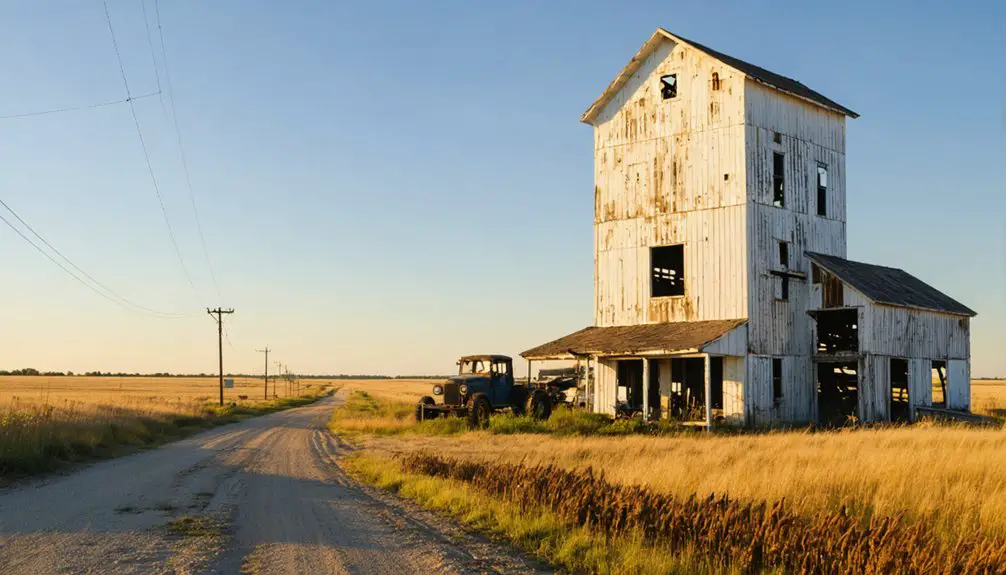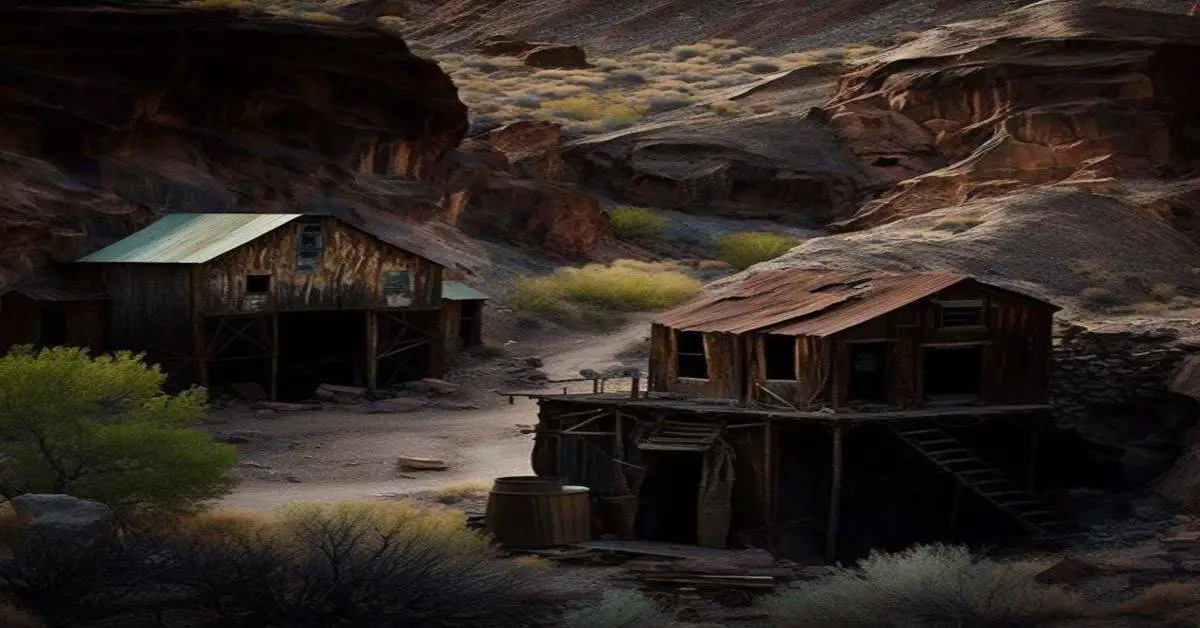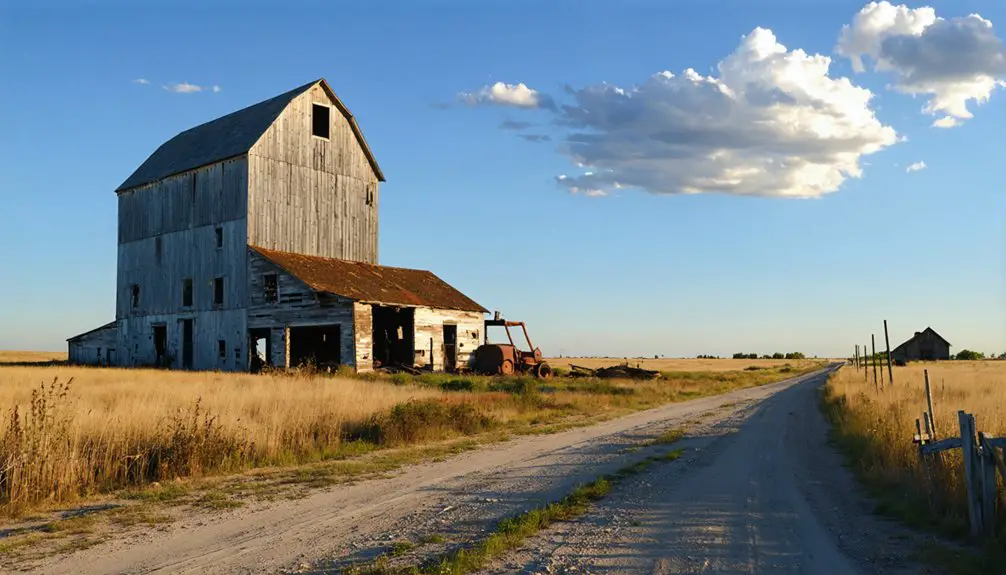You’ll find Amidon, North Dakota clinging to existence with just 22 residents, most over age 65. As Slope County’s seat, this former agricultural hub has weathered dramatic population decline since its late 19th-century founding. Today’s residents face long commutes and limited services, while local haunts like George’s and the Owl restaurant draw paranormal enthusiasts. Behind Amidon’s quiet streets lies a compelling story of prairie settlement’s rise, decline, and stubborn persistence.
Key Takeaways
- Amidon maintains a tiny population of 22-23 residents, mostly elderly, indicating near ghost town status in modern times.
- The town experienced significant decline after abandoned railroad plans during World War I limited its growth potential.
- All current residents own their homes, with modest property values around $75,000, preventing complete abandonment.
- The town’s demographic trends show severe population aging, with nearly half of residents 65 or older.
- Despite ghost town characteristics, Amidon remains officially inhabited as Slope County’s seat with a functioning courthouse.
The Rise and Fall of a Prairie Settlement
While many prairie settlements emerged during North Dakota’s territorial period, Amidon’s story stands out as a testimony to the fleeting nature of frontier development.
You’ll find its roots in the late 19th century, when it became Slope County’s seat, positioned within the rugged Little Missouri National Grassland. The town’s early growth followed crucial transportation routes, particularly railroad expansions that shaped prairie communities. Like many towns where abandoned sites remain, Amidon’s history represents the pattern of settlement and decline common in North Dakota. The courthouse records provide detailed accounts of the town’s early governance and development.
Despite its small size, Amidon showed remarkable community resilience, establishing essential services like schools, churches, and local businesses. The town’s economy thrived on ranching and small-scale agriculture, serving as a hub for scattered rural populations.
Against all odds, Amidon built a vibrant prairie community, weaving together commerce and culture to support the region’s scattered homesteads.
However, by the 1920s, increased automobile use and bypassed railroad lines redirected growth elsewhere. Agricultural mechanization further reduced the need for rural labor, leading to Amidon’s gradual decline into near-ghost town status.
Life in Modern-Day Amidon
Today’s Amidon bears little resemblance to its early frontier days, with only 22-23 residents calling this remote prairie settlement home.
You’ll find a tight-knit elderly community here, where nearly half the population is 65 or older. Community engagement centers around a handful of neighbors who’ve weathered economic challenges together, with poverty rates hovering around 50%. The town’s median age of 64.8 years reflects its aging demographic. The typical household earns just around $35,000 annually.
While local traditions persist among the mainly white population, daily life requires adaptation. Most residents commute nearly 27 minutes for work, relying on their personal vehicles in this car-dependent town.
There’s a stark absence of young families, with just two residents under 18. Despite economic hardships, everyone owns their home, though property values remain modest at around $75,000.
Healthcare access and senior services shape much of the community’s current needs.
Haunted Tales From George’s and the Owl
Among Amidon’s few remaining establishments, George’s and the Owl restaurant stands as more than just the town’s sole dining venue – it’s gained notoriety as one of North Dakota’s most haunted locations.
When you visit, you’ll find yourself in a setting where ghostly encounters have become commonplace, with staff and diners reporting spectral sightings that defy explanation.
Most striking are the three distinct faces that have appeared in the upstairs dining room mirror, alongside unexplained moving objects and mysterious sounds throughout the premises. Delivery drivers have reported hearing mysterious conversations and voices while alone in the building.
As the smallest county seat in America, Amidon’s isolated location adds to the restaurant’s mystique.
The restaurant’s supernatural reputation has earned it prominence in books and websites dedicated to paranormal activity.
Set against the backdrop of Little Missouri National Grassland’s stark landscape, these haunting tales have transformed this small-town eatery into a destination for those seeking otherworldly experiences.
Agricultural Legacy and Economic Changes
Beyond the spectral tales of George’s and the Owl, Amidon’s deeper history lies in its agricultural roots during North Dakota’s farming boom.
You’ll find that early settlers embraced wheat varieties like Bluestem and Red Fife, until Russian-origin durum wheat proved more resilient against drought and rust disease.
As economic challenges mounted between 1900 and 1915, local farmers pursued crop diversification, adding oats, barley, flax, and cattle to their operations. During this period, inequities for farmers led many local agricultural families to support the reform-focused Nonpartisan League.
The Bank of North Dakota’s establishment in 1919 offered hope through low-interest loans, but the Great Depression and Dust Bowl dealt crushing blows.
Despite Amidon’s promise as a county seat in 1916, the abandoned railroad plans during WWI limited its growth potential.
Preserving Memories of Small-Town America
While physical structures crumble and populations dwindle, dedicated efforts to preserve Amidon’s history continue through multiple channels.
Just as harsh weather conditions contributed to the abandonment of towns like Charbonneau, Amidon faced similar environmental challenges that shaped its destiny.
You’ll find the town’s legacy captured in newspaper archives at the North Dakota Historical Society, while county courthouse records reveal the legal and administrative chapters of its past.
Community storytelling remains crucial, as local families pass down memories that connect past to present.
Stories shared across generations weave an unbroken thread of community memory, keeping local history alive through cherished family tales.
Like the historic Sims Scandinavian Lutheran Church, Amidon’s religious buildings serve as landmarks of its cultural identity.
Through oral histories collected by regional museums like the Pioneer Trails Regional Museum, you’re able to glimpse the authentic experiences of former residents.
Even as buildings fade, the town’s cultural heritage lives on through active churches and cemeteries that serve as gathering places.
These preservation efforts guarantee that Amidon’s story – a reflection of rural America’s resilience and transformation – won’t be forgotten.
Frequently Asked Questions
Are There Any Remaining Original Buildings From Amidon’s Early Settlement Period?
You’ll find some original architecture still exists in the area, including the historically preserved HT Ranch, but Amidon’s early settlement buildings are sparse since the wooden courthouse’s demolition in 2014.
What Is the Average Age of Current Amidon Residents?
You’ll find today’s average resident age in Amidon is around 64.8 years, reflecting historical population trends that show an aging demographic with few young families and nearly half the residents over 65.
How Far Is Amidon From the Nearest Major City?
Like driving across an endless prairie sea, you’ll need to traverse roughly 140-150 miles of rural travel routes from Amidon to reach Bismarck, North Dakota’s nearest major metropolitan center.
Does Amidon Hold Any Annual Events or Festivals?
You won’t find any annual events or festivals in Amidon. Due to its ghost town status and tiny population, local traditions and Amidon celebrations have ceased. You’ll need to visit nearby towns instead.
Can Visitors Explore Abandoned Properties in Amidon Without Special Permission?
No, you can’t freely explore abandoned properties – visitor regulations require explicit permission from owners. Most locations are private property with posted restrictions, making unauthorized exploration illegal and potentially dangerous.
References
- https://northernsentry.com/2023/05/12/ghosts-of-north-dakota/
- https://www.youtube.com/watch?v=0-8dBwawqKo
- https://freepages.history.rootsweb.com/~gtusa/usa/nd.htm
- https://www.outsideonline.com/adventure-travel/destinations/north-america/raising-north-dakota
- https://news.prairiepublic.org/main-street/2018-10-25/small-town-desart
- https://northernsentry.com/2025/06/26/north-dakota-ghost-towns/
- https://www.northdakota-demographics.com/amidon-demographics
- https://worldpopulationreview.com/us-cities/north-dakota/amidon
- https://www.aterio.io/insights/us-population-forecast/nd
- https://www.neilsberg.com/insights/amidon-nd-population-by-age/



